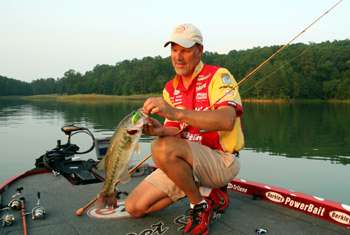
According to 2007 Bassmaster Classic champion Boyd Duckett, postspawn/early summer bassin' can be one of the most productive times of the year if it's approached correctly. Approaching things correctly means thinking about what the bass are doing and then fishing with a plan.
"Immediately after the spawn, the big females go into a kind of funk for two or three weeks — sometimes as long as a month. They don't recover as fast as many anglers think, and fishing can get tough. But, after they pass through that stage they'll eat until the dog days of summer," he says.
"When they start feeding, I look for baits that move quickly. I want to take advantage of their appetites. Two of my favorite lures at this time of the year are buzzbaits and deep-diving crankbaits. They'll both catch huge stringers of bass in June and early July, if you fish them in the right places.
Duckett reminds us that bass are going off crawfish and the shallow water feed. They're starting to eat baitfish. That requires a change of tactics if you expect to be successful. Success won't come from merely switching lures, however. There's more to it than that.
"I start near the spawning flats with my trolling motor on high and work my way out towards the deeper ledges and channels. Bass don't turn around and just swim out into deep water. It doesn't happen overnight. They move slowly as their metabolism stabilizes, they gain strength and their appetites increase."
As they're making their move Duckett will search for them with a buzzbait. His preference is for a custom model built locally near his home in Demopolis, Ala.
"I have them put the blade from a 3/8-ounce bait on a 1/2-ounce body and I do that with all my sizes. In other words, I always downsize my blade at least one full size. The smaller blade creates less air resistance on the cast. And, I want to make long casts, always keeping my lure as far away from the boat as possible. That'll help avoid short strikes.
"If you think about it, almost all your short strikes come close to the boat, on the second half of the cast. That's because the fish get hesitant and skittish when they're near a big bass boat. They want to eat but they're afraid; their strike is tentative. Keep your buzzbait away from the boat. You'll catch more bass that way."
Once the bass have moved out to deep water Duckett breaks out his crankbaits. He concentrates on river channels, creek channels, drops and ledges — "key feeding areas" as he calls them — for this pattern.
"All reservoirs will have a cranking pattern at this time of year — I don't care where it's at. The key is to throw them in the right places. Channels, drops and ledges are the right places. That's where you'll find bass. True, some of them might wander into shallow areas occasionally, but that's all they're doing, wandering. They want to be on the drops."
But, keep in mind why the bass are there … at least according to Duckett. It's not because they like channels and drops. It's because the food's there — the baitfish. That's always going to be true no matter where you're fishing. The key to the pattern is to find those areas where there's a drop and baitfish. That area's called a crankbait hole.
All that said, however, Duckett has a word of warning for his fellow anglers. "This is not a fall baitfish situation. Don't try to match the hatch. That's important in the fall, but not now. It means nothing in early summer. A big, heavy Fat Free Shad — that's what I throw most of the time — doesn't look like a threadfin shad but they eat it because they're feeding and it's moving fast.
"And, don't expect every spot to have bass on it. Don't get discouraged if you have to fish three, four or even five places before you find a bunch of them. That might be a lot of work, but it'll be worth it in the end because once you do find them it's 'bite on!' You can whack a bunch of three- and four-pounders in just a few minutes."
Originally published June 2008




